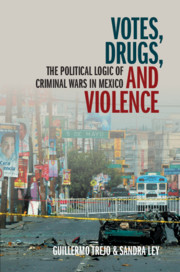Book contents
- Votes, Drugs, and Violence
- Cambridge Studies in Comparative Politics
- Votes, Drugs, and Violence
- Copyright page
- Contents
- Figures
- Maps
- Tables
- Preface
- Acronyms
- Introduction
- Part I A Political Theory of Criminal Violence
- Part II The Outbreak of Inter-Cartel Wars
- Part III The State’s War Against the Cartels
- 4 Why the State’s War against the Cartels Intensified Violence
- 5 Unpacking the War on Drugs
- Part IV The Rise of Criminal Governance: Subverting Local Democracy in War
- Appendix A Criminal Violence in Mexico Database (CVM)
- Appendix B Criminal Attacks Against Political Actors in Mexico (CAPAM) Database
- Appendix C Chapter 2. Multivariate Regression Models (Robustness Checks)
- Appendix D Chapter 4. Multivariate Regression Models (Robustness Checks)
- Appendix E Chapter 4. Natural Experiment (Additional Information)
- Appendix F Chapter 6. Multivariate Regression Models (Robustness Checks)
- Appendix G Chapter 6. Natural Experiments (Additional Information)
- References
- Index
- Other Books in the Series (continued from page iii)
5 - Unpacking the War on Drugs
Presidents, Governors, and Large-Scale Narco Violence
from Part III - The State’s War Against the Cartels
Published online by Cambridge University Press: 16 September 2020
- Votes, Drugs, and Violence
- Cambridge Studies in Comparative Politics
- Votes, Drugs, and Violence
- Copyright page
- Contents
- Figures
- Maps
- Tables
- Preface
- Acronyms
- Introduction
- Part I A Political Theory of Criminal Violence
- Part II The Outbreak of Inter-Cartel Wars
- Part III The State’s War Against the Cartels
- 4 Why the State’s War against the Cartels Intensified Violence
- 5 Unpacking the War on Drugs
- Part IV The Rise of Criminal Governance: Subverting Local Democracy in War
- Appendix A Criminal Violence in Mexico Database (CVM)
- Appendix B Criminal Attacks Against Political Actors in Mexico (CAPAM) Database
- Appendix C Chapter 2. Multivariate Regression Models (Robustness Checks)
- Appendix D Chapter 4. Multivariate Regression Models (Robustness Checks)
- Appendix E Chapter 4. Natural Experiment (Additional Information)
- Appendix F Chapter 6. Multivariate Regression Models (Robustness Checks)
- Appendix G Chapter 6. Natural Experiments (Additional Information)
- References
- Index
- Other Books in the Series (continued from page iii)
Summary
This chapter unpacks the federal intervention in the War on Drugs and analyzes the strategies the president followed across states depending on governors’ political affiliations. We disaggregate the intervention on the military, judicial, communicative, and social policy dimensions and assess patterns of cooperation and conflict between federal and subnational authorities. Using extensive interviews with federal and subnational elites and case studies from three cities in three states, we show how Mexico’s federal government followed differentiated strategies to deal with drug violence. The president protected subnational co-partisans (PAN) in Tijuana (PAN); partially cooperated with centrist opposition authorities (PRI) in Ciudad Juáreza; but confronted leftist governors and mayors (PRD), leaving them at the mercy of drug cartels in Apatzingán. Cartels responded by launching strategic attacks and challenging their rivals in municipalities with vulnerable leftist states.Thus, the politicization of law enforcement in the War on Drugs – which was possible because Mexico transitioned to electoral democracy without developing the rule of law – became a major stimulant of violence.
Keywords
- Type
- Chapter
- Information
- Votes, Drugs, and ViolenceThe Political Logic of Criminal Wars in Mexico, pp. 180 - 212Publisher: Cambridge University PressPrint publication year: 2020

